Schachtelmonokular 5x12,5Das 60x46x20mm große und nur 87g schwere Monokular hat eine Schachtelform, ähnlich den neueren Nikon 6x15p und dem heutigen Nikon 6x15 II. Es gibt keinen Hinweis auf einen Hersteller oder Produktionsdatum, könnte aber aufgrund der Ähnlichkeit ein Vorläufermodell sein. Die unvergüteten Linsen sprechen für ein Herstellungsdatum vor dem 2. Weltkrieg.Das abgerundete Gehäuse hat eine Lederummantelung und blanke Aluminiumdeckel. Am Objektivdeckel befindet sich außen ein Fokussierungsrädchen und oben auf ein weiteres Stellrad zum Vorklappen einer Lupenlise. Bei einem weiteren mir vorliegendem Exemplar gibt es keine vorklappbare Nahlinse. |
Box Monocular 5x12.5This 60x46x20mm and 87g monocular has a box shape, resembling the 80s Nikon 6x15p and today's Nikon 6x15 II. There are no clues at a maker or date of production. But maybe this is a precesspr of the Nikons. The uncoated lenses hint at a production time before WWII.The box with rounded edges has a leather covering and polished aluminium covers. There is a tiny focusing wheel at the side of the objective cover, and on top another wheel for sliding a magnifying lens in front of the objective. A second box monocular I have is identical apart from the sliding close-up lens. |
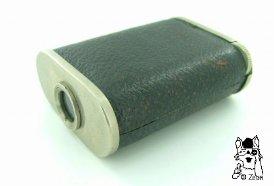
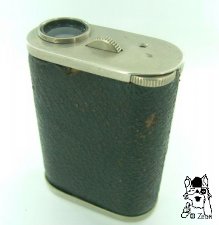
| Das geöffnete Gehäuse offenbart ein ausgeklügeltes Porro-I Prismensystem. Es gibt zwei Messing Trägerstäbe, die als Aufhängung für 4 Aluplatten dienen. An den äußeren Platten ist das Okular (11mm Okularlinse) und die 12,5mm Objektivlinse eingeschraubt, an den zwei mittleren Platten befinden sich runde Bohrungen für den Strahlengang und mit Klemmen befestigte kleine Porroprismen. Die okularseitige Prismenplatte steht fest, während sich die objektivseitige anhand eines Schneckengewindes zum Fokussieren vor- und zurückschieben lässt. Dieses Schneckegewinde lässt sich durch Drehen des seitlichen Stellrades am Objektivdeckel bewegen. Diese Fokussierung erreicht eine Schärfenbereich von 30cm bis unendlich, wobei die Vergrößerung in der Nähe ca. 5fach, in der Ferne ca. 3,5fach ist. |
The opened housing reveals a smart porro I system. There are two brass rods used to mount 4 aluminium plates. The outer plates carry the ocular (lens is 11mm in diameter) and the 12.5mm objective lens. The two inner plates have round boreholes to let through the light beams as well as to carry small porro prisms fixed by clamps. The ocular side plate is inmobile, whereas the objective side plate can be moved to and fro by means of a worm thread to focus. It is moved by turning the small wheel at the side of the objective cover. This system has a focussing range from 30cm to infinity. Magnification at near focus is ca. 5 times, and at far distances 3.5 times. |
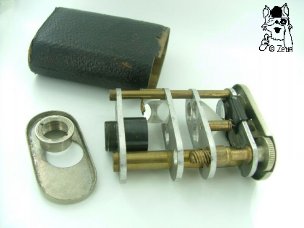
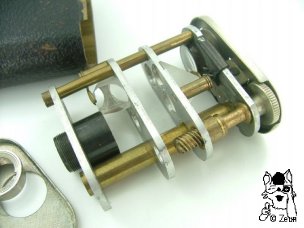
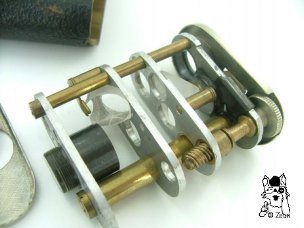
| Das zweite Rädchen bewegt mitttels eines Doppelstifts (s. Foto) einen Schlitten mit Lupe innerhalb des Gehäuses vor das Objektiv bzw. wieder weg. Dadurch wird bei einem Fokussierungsabstand von 55mm schätzungsweise eine 20fache Vergrößerung erreicht- | The second wheel with two attached pins (s. pic) moves a lens mounted on a sort of sledge inside the housing in front of the objective and vice versa. A magnification of about 20 times is thus reached at a viewing distance of 55mm. |
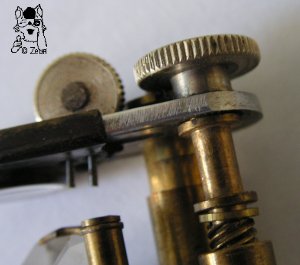
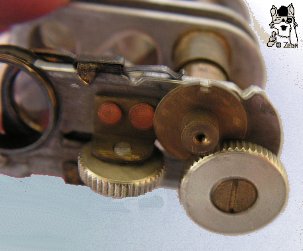
| Vgl. a. x5 Spy Prismatic Monokular. | Cf. a. x5 Spy Prismatic Monocular. |
Fotos: Zeun

